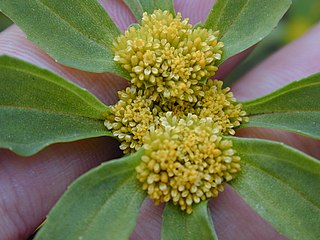
Flaveria is a genus of plants in the family Asteraceae. They are sometimes called yellowtops. Some are annual or perennial herbs and some are shrubs. They bear yellow flowers in heads, with zero, one, or two ray florets in each head. These plants are found in the Americas, Asia, Africa, and Australia.

Flaveria trinervia is a species of flowering plant in the family Asteraceae known by the common names clustered yellowtops, speedyweed, and yellow twinstem. It is native to parts of the Americas, including the southeastern and southwestern United States, most of the Bahamas, Mexico, Belize, and parts of the Caribbean, especially Cuba, Cayman Islands, Jamaica, Hispaniola, Puerto Rico and Barbados. It is also known in many other places as an introduced species and often a noxious weed, such as in Hawaii.

Rafinesquia neomexicana is a species of flowering plant in the family Asteraceae. Common names include desert chicory, plumeseed, or New Mexico plumeseed. It has white showy flowers, milky sap, and weak, zigzag stems, that may grow up through other shrubs for support. It is an annual plant found in dry climate areas of the southwestern deserts of the US and northwestern deserts of Mexico.
Flaveria chlorifolia, the clasping yellowtops, is a North American plant species of Flaveria within the family Asteraceae. It is native to the southwestern United States and northern Mexico.

Tetraneuris acaulis is a North American species of flowering plants in the sunflower family. Common names include angelita daisy, stemless four-nerve daisy, stemless hymenoxys, butte marigold, and stemless rubberweed.

Flaveria campestris, common name alkali yellowtops, is a plant species native to the southwestern United States and to the southern Great Plains. It is found on saline soils and on the margins of lakes, ponds and streams.

Flaveria bidentis, the coastal plain yellowtops, is a South American plant species of Flaveria within the family Asteraceae. It is native to South America, and naturalized in many places.
Flaveria brownii, or Brown's yellowtops, is a North American plant species of Flaveria within the family Asteraceae. It is found only in the coastal regions of southern Texas in the United States. It grows primarily in sand dunes and salt marshes close to the Gulf of Mexico.
Flaveria pubescens is a rare Mexican plant species of Flaveria within the family Asteraceae. It has been found only in the States of Tamaulipas and San Luis Potosí in northeastern Mexico.
Flaveria oppositifolia is a rare Mexican plant species of Flaveria within the family Asteraceae. It has been found only in northeastern Mexico, from Tamaulipas west to Coahuila, south as far as Hidalgo and Aguascalientes. Some sources report the species to be present in the State of Texas in the United States, but the Texas populations have been recognized as a distinct species, F. brownii.
Flaveria floridana, the Florida yellowtops, is a North American plant species of Flaveria within the family Asteraceae. It has been found only along the Gulf Coast of Florida between Clearwater and Marco Island, mostly in the Tampa Bay region.
Flaveria linearis, known as narrowleaf yellowtops, is a North American plant species of Flaveria within the family Asteraceae. It is native to Florida, Cuba, Bahamas, and the Yucatán Peninsula of Mexico.
Flaveria sonorensis is a rare Mexican plant species of Flaveria within the family Asteraceae. It has been found only in southern Sonora and southwestern Chihuahua in northwestern Mexico. Some of the populations lie very close to hot mineral springs.
Flaveria angustifolia is a Mexican plant species of yellowtops within the family Asteraceae. It has been found only in central Mexico, in Oaxaca, Guerrero, Puebla, and the Distrito Federal.
Flaveria mcdougallii is a very rare North American plant species of Flaveria within the family Asteraceae. It has been found in 4 locations in the Grand Canyon in northwestern Arizona in the southwestern United States, in Mohave County and Coconino County. Many of the populations lie inside Grand Canyon National Park, others within the Hualapai Indian Reservation.
Flaveria cronquistii is a rare Mexican plant species of Flaveria within the family Asteraceae. It has been found only in the States of Puebla and Oaxaca in central Mexico.
Flaveria robusta is a rare Mexican plant species of Flaveria within the family Asteraceae. It has been found only in Colima and nearby western Michoacán in west-central Mexico.
Flaveria palmeri is a rare Mexican plant species of Flaveria within the family Asteraceae. It has been found only in the States of Coahuila and Nuevo León in northeastern Mexico.
Flaveria anomala is a Mexican plant species of yellowtops within the family Asteraceae. It has been found only in northeastern Mexico, in Coahuila, San Luis Potosí, Tamaulipas, Nuevo León, and Zacatecas.
Flaveria ramosissima is a rare Mexican plant species of Flaveria within the family Asteraceae. It has been found only in the States of Puebla and Oaxaca in central Mexico.





